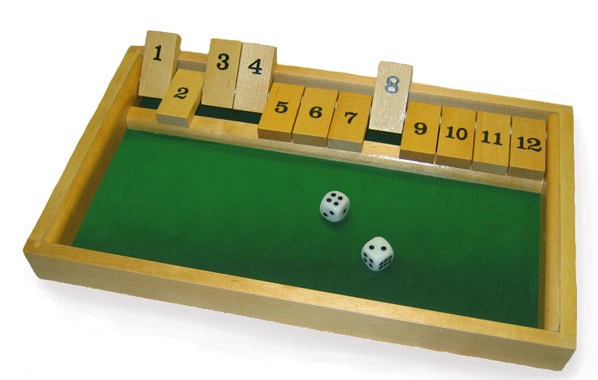Or search by topic
Number and algebra
Geometry and measure
Probability and statistics
Working mathematically
Advanced mathematics
For younger learners
Shut the Box for Two



- Game
Here's a game to play with an adult!

How do you play?
You will need an adult to play with.
You will also need two dice (you could use our interactive dice) and cards with the numbers 1 to 12 on them, which you can print off from here.
The aim of the game is to turn over all the cards. You can turn over the cards that match the numbers on the dice.
To play the game, start with the numbers showing on all the cards. The adult rolls the two dice first. They can turn over the cards which are the same as the numbers rolled. For example, if a 4 and a 5 are rolled, they would turn over the 4 and 5 cards. If a double is thrown, their turn ends. They can roll the dice again until they can't turn over any more cards. The cards that are left
showing are then added and that is their score.
You then take the dice and turn the cards the right way up again, and then roll the dice in the same way as the adult. You can keep on rolling dice as long as each time you can turn over some new cards. Remember that if a double is thrown, your turn ends. When you can't turn over any more cards, those that are left are added together and that is your score.
The winner is the person with the lower score. It can be played with just one turn each or each player can have a number of turns that you decide at the beginning of the game.
Can you explain your strategy?
What is good about the game? What is not so good? Why?
How could you alter the rules to make it better?
This game can give children the opportunity to use their number knowledge. Altering the rules will give the children opportunities to explore ideas about what makes a "good" game and to develop winning strategies to play their games.
Easier version: try starting with just the numbers 1 to 6.
Harder version: try inventing new rules, or adding, subtracting or multiplying the scores on the two dice together to find the number to turn over. You could also change the rule which ends the turn when a double is thrown.
There's a classroom version of this game here.
You may also like
Homes
Six new homes are being built! They can be detached, semi-detached or terraced houses. How many different combinations of these can you find?
Number Squares
Start with four numbers at the corners of a square and put the total of two corners in the middle of that side. Keep going... Can you estimate what the size of the last four numbers will be?

